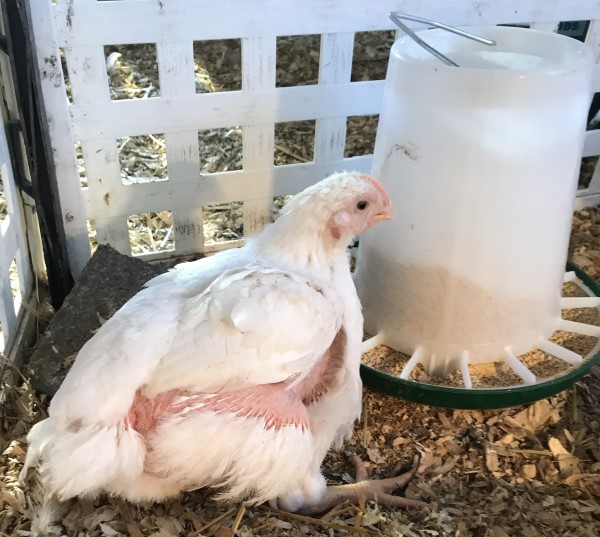
The images from factory farms can be very disturbing. Thousands of layer hens crammed into tiny cages, de-beaked as chicks so they don’t peck each other to death, their feet cramped as they walk on feces-covered wire mesh, and a constant stream of “feed” in front of them, sometimes made from the by-products of their fallen brethren. Even the “cage-free” broiler chickens are housed wing-to-wing in massive buildings, devoid of sunlight and walking on layers of crap. Never touching grass nor eating a bug in their short lives, usually just four to six months on earth. It’s enough to make a person go vegetarian. Or, at least buy their meat and eggs from smaller, more humane sources.
It made me decide to raise our own meat birds on the homestead. And it was definitely eye-opening.
I was always told that the broiler chickens in most farms were pumped full of growth hormones so they could reach optimum weight as quickly as possible. It sounded plausible, and maybe still happens on some farms (despite the increase in cost). But mostly, these birds are simply bred to grow that way, without the need for injections. It’s in their DNA to be fat and lazy. You can debate the ethics of that; I’m just here to state what I have experienced.
One spring I bought five straight-run Cornish Cross broilers and five Black Australorp layer hens on the same day. As they grew for about three or four weeks, I noticed the broilers became almost double the size of the layers. I didn’t inject them with any steroids or supplements. And they all had the same access to food, housing and water.
When they were large enough to leave the coop and explore our acreage, the Australorps literally jumped at the chance. (If you’ve never seen pullets experience the outdoors for the first time, it is one of the most heart-warming, joyful experiences. They leap and flap their wings in a pure expression of happiness.) That’s what the layers did. The broilers stayed in the coop, close to the food and water, sometimes just lying in front of the food bin.
At one point I took the broilers outside, thinking that if they just experienced the world, they would enjoy it. I was wrong. They seemed disinterested. In fact, they walked back in the coop after just a few minutes. Many people mention how the broilers do not like to stand or walk, because their bodies grow faster than their legs and muscles can keep up with. This may be true in some cases, but in my case the birds were able to walk and run like the other chickens, they just didn’t seem to want to. Their laziness has to be genetic.
By the time the two sets of pullets had grown in all their adult feathers, the broilers were the same size as our Salmon Favrelles and the Australorps were still about half that size. We harvested the broilers, far away from the sight of the rest of the flock (chickens know when their mates are being butchered and it traumatizes them).
So if you’re looking to raise meat birds and want them to be free-range, I suggest Rhode Island Reds or Barred Plymouth Rocks. They will leave the coop to fatten themselves on seeds and bugs and other delicacies. It will take longer, but they’ll be more nutritious and happier in the process.
Ben North lives and writes from a homestead in Iowa.

Vincent says
Most commercially available meat breeds have been bred for maximum growth rates. No real need to pump hormones. USDA does not allow legal use of hormones anyway.
While it does take a little more time to get to butcher size, I much prefer to get heritage breeds and help perpetuate those breeds. Most people find the old breeds also have a real chicken flavor. At least they live long enough to develop some flavor. Factory farm chicken is so young they have not developed any taste. That is why everything tastes like chicken. Because commercial chicken has no taste.
We raise, hunt or fish for nearly all our meat on my little farm( 180 acres) We also do most of the field work with horses and grow mostly heritage crops in the garden. We have tried many different hybrids and commercial plants and just like the heritage plants and animals better.
Tom Blackwell says
USDA prohibits hormones to be used in raising broilers. Hormones fed to chickens is a myth and used as fear mongering marketing to the uninformed.
Good article.